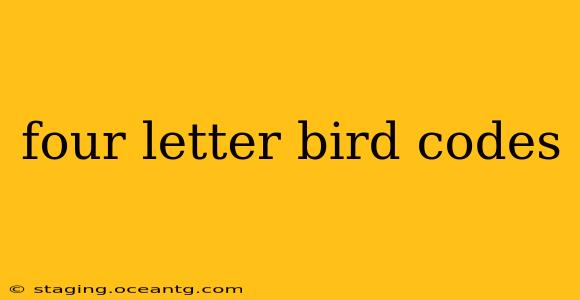For bird enthusiasts, ornithologists, and anyone fascinated by avian life, understanding bird codes can be incredibly useful. This article delves into the world of four-letter bird codes, exploring their purpose, common uses, and how to decipher them. While there isn't one universally standardized four-letter bird code system, we'll explore the most likely scenarios and potential interpretations.
What are Four-Letter Bird Codes Used For?
The use of four-letter codes for birds isn't as widespread or standardized as some might think. Instead of a single, overarching system, these codes likely appear in specific contexts, such as:
-
Internal Databases & Bird Banding: Wildlife organizations and researchers often use abbreviated codes internally to manage large datasets on bird populations. These codes may be unique to a specific organization or project and not publicly available. The codes might represent species, locations, or even individual birds.
-
Citizen Science Projects: Some citizen science initiatives that track bird sightings might employ four-letter codes for streamlined data entry and analysis. Again, these would be specific to the project.
-
Aviation: While less likely to be directly related to bird species, four-letter codes are frequently used in aviation for airport identifiers. It's possible a misunderstanding or confusion could lead to interpreting these as bird codes.
-
Gaming or Fictional Contexts: Finally, four-letter bird codes could appear in video games, books, or other fictional works where a shortened, unique identifier is needed.
How to Decipher Potential Four-Letter Bird Codes
Since there's no central registry of four-letter bird codes, deciphering any encountered code requires context. To understand what a particular four-letter code means, you’d need to:
-
Identify the Source: Where did you encounter this code? Knowing the source (a research paper, a website, a game, etc.) provides crucial context.
-
Look for a Key: Does the source provide a key or legend that explains the code's meaning? Many databases or projects will include a guide to their internal codes.
-
Consider the Context: What is the surrounding text or information about? This can provide clues about the intended meaning of the code.
Are there Standard Three- or Four-Letter Bird Abbreviations?
While a universal four-letter system doesn't exist, many bird species have common three- or four-letter abbreviations derived from their scientific or common names. These abbreviations, however, are usually context-dependent and not consistently used across all sources. For example, you might see abbreviations like:
- ROBI: (Possibly referring to a Robin) However, this is not a standardized code.
It's crucial to understand that these aren't standardized codes like airport codes. Their meaning is entirely dependent on the context in which they are used.
Why Aren't There Standardized Four-Letter Bird Codes?
Several factors explain the absence of a universally recognized four-letter bird code system:
-
Complexity of Bird Taxonomy: With thousands of bird species worldwide, creating and maintaining a standardized four-letter code system would be incredibly complex. Slight changes in taxonomy could require extensive updates.
-
Existing Identification Systems: Established systems like the scientific names (binomial nomenclature) and common names already provide clear and widely accepted ways to identify bird species. There's less need for an additional code system.
-
Regional Differences: Bird names and common knowledge about birds can vary considerably across regions, making a global four-letter code system difficult to implement.
What Other Bird Identification Methods Exist?
Beyond potential, context-dependent four-letter codes, several reliable methods exist for identifying birds:
-
Field Guides: Comprehensive field guides with detailed illustrations and descriptions are invaluable for bird identification.
-
Online Resources: Numerous websites and apps offer bird identification tools, often using image recognition.
-
Birdwatching Apps: These apps often have image recognition capabilities, species lists for your region, and opportunities to log sightings.
In conclusion, while you may encounter four-letter bird codes, they lack a universal standard. Their meaning is completely context-dependent. For reliable bird identification, always rely on established field guides, online resources, and reputable birdwatching apps.
